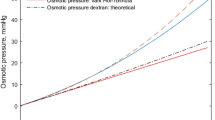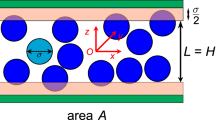Abstract
PRESSURE gradients at interfaces of porous membranes can be caused by two factors: (1) discrete changes in concentrations of particles which are excluded from the aqueous pores because of their size, and (2) electrical stresses which are caused by the action of an electric field on the charged particles at the membrane–solution boundary (A.I., theoretical results to be published elsewhere). Only the first factor is important in neutral pore-containing membranes; the second operates at the boundary of charged pores, that is, in ion exchange membranes.
This is a preview of subscription content, access via your institution
Access options
Subscribe to this journal
Receive 51 print issues and online access
$199.00 per year
only $3.90 per issue
Buy this article
- Purchase on Springer Link
- Instant access to full article PDF
Prices may be subject to local taxes which are calculated during checkout
Similar content being viewed by others
References
Guggenheim, E. A. Thermodynamics, 337 (North-Holland, Amsterdam, 1950).
Lakshminanayanaiah, N. Transport Phenomena in Membranes, 82 (Academic, New York and London, 1969).
Mauro, A. Biophys. J. 2, 179–198 (1962).
Mackay, D. & Mears, P. Kolloid, Z. 167, 31–39 (1959).
Author information
Authors and Affiliations
Rights and permissions
About this article
Cite this article
ZOROF, E., ILANI, A. Transient pressure changes in Donnan systems displaced from equilibrium. Nature 267, 362–364 (1977). https://doi.org/10.1038/267362a0
Received:
Accepted:
Issue Date:
DOI: https://doi.org/10.1038/267362a0
This article is cited by
-
The development of pressure across membranes in Donnan systems
Scientific Reports (2015)
Comments
By submitting a comment you agree to abide by our Terms and Community Guidelines. If you find something abusive or that does not comply with our terms or guidelines please flag it as inappropriate.



